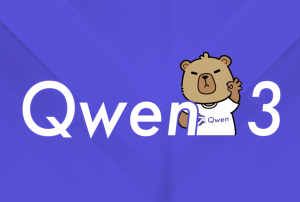Alibaba Unveils Qwen3 AI Models, Challenging US Tech Giants
Chinese technology giant Alibaba Group Holding Ltd. has announced the release of Qwen3, a new family of artificial intelligence models that it claims can outperform competing models from companies such as OpenAI and Google LLC. The announcement underscores the rapid pace of development within China’s AI industry since DeepSeek Ltd.’s breakthrough late last year.
The e-commerce giant said the new Qwen3 models surpass DeepSeek’s best models in several areas, including coding and math-based problems. Alibaba is releasing various models within the Qwen3 family under an open-source license, ranging in size from 600 million to 235 billion parameters, a measure that roughly corresponds to problem-solving abilities. Generally, the more parameters a model has, the better it performs.

The Qwen3 series includes two “mixture of experts” (MoE) models that Alibaba claims can compete with the most advanced reasoning models launched by Google and Anthropic PBC. These reasoning models are designed to mimic human thought processes, taking more time to consider problems and perform fact-checking for accuracy. By using the MoE technique, AI models can enhance their reasoning skills by dividing tasks into smaller segments, similar to how a company might employ teams of specialists to focus on specific parts of a challenging problem.
Alibaba’s Qwen team explained in a blog post that they have “seamlessly integrated thinking and non-thinking modes, offering users the flexibility to control the thinking budget.” This design enables users to configure task-specific budgets with greater ease. The Qwen3 models support 119 languages and have been trained on a dataset containing almost 36 trillion tokens, which are the raw bits of data they process during training.
In various benchmark tests, Alibaba’s Qwen3 models delivered impressive results, edging out recent “high-end” models from U.S.-based AI companies, such as OpenAI’s o3-mini and o4-mini models. For instance, on the Codeforces benchmark that measures models’ ability to write code, the largest Qwen-3-235B-A22B model surpassed o3-mini and Google’s Gemini 2.5 Pro. It also outperformed o3-mini on the AIME mathematics benchmark and the BFCL test that assesses AI models’ reasoning abilities.
The emergence of powerful, open-source Chinese AI models has raised the stakes for U.S. AI companies, which were until recently seen as industry leaders. However, their status is now under threat, particularly because American-made models are generally trained at much higher costs than their Chinese counterparts. The U.S. government has responded by introducing further sanctions aimed at preventing Chinese companies from accessing powerful graphics processing units used to train and run AI models.
Alibaba CEO Eddie Wu stated in February that the company’s main objective is to build an “artificial general intelligence” system that will ultimately surpass human intellectual capabilities. This development highlights the intensifying competition in the AI landscape between Chinese and U.S. tech companies.


